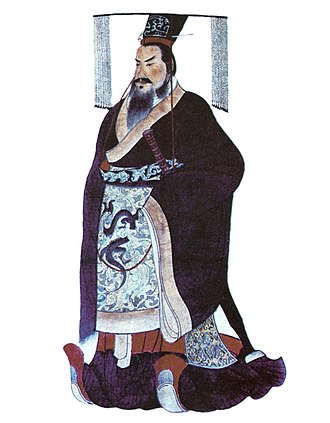始皇
Hello, you have come here looking for the meaning of the word 始皇. In DICTIOUS you will not only get to know all the dictionary meanings for the word 始皇, but we will also tell you about its etymology, its characteristics and you will know how to say 始皇 in singular and plural. Everything you need to know about the word 始皇 you have here. The definition of the word 始皇 will help you to be more precise and correct when speaking or writing your texts. Knowing the definition of始皇, as well as those of other words, enriches your vocabulary and provides you with more and better linguistic resources.

始皇
Chinese
| beginning; first | emperor | ||
|---|---|---|---|
| trad. (始皇) | 始 | 皇 | |
| simp. #(始皇) | 始 | 皇 | |
| Literally: “first emperor”. | |||
Pronunciation
- Mandarin
- Cantonese (Jyutping): ci2 wong4
- Southern Min
- Mandarin
- (Standard Chinese)+
- Hanyu Pinyin: Shǐhuáng
- Zhuyin: ㄕˇ ㄏㄨㄤˊ
- Tongyong Pinyin: Shǐhhuáng
- Wade–Giles: Shih3-huang2
- Yale: Shř-hwáng
- Gwoyeu Romatzyh: Shyyhwang
- Palladius: Шихуан (Šixuan)
- Sinological IPA (key): /ʂʐ̩²¹⁴⁻²¹ xu̯ɑŋ³⁵/
- (Standard Chinese)+
- Cantonese
- (Standard Cantonese, Guangzhou–Hong Kong)+
- Jyutping: ci2 wong4
- Yale: chí wòhng
- Cantonese Pinyin: tsi2 wong4
- Guangdong Romanization: qi2 wong4
- Sinological IPA (key): /t͡sʰiː³⁵ wɔːŋ²¹/
- (Standard Cantonese, Guangzhou–Hong Kong)+
- Southern Min
- (Hokkien: General Taiwanese)
- Pe̍h-ōe-jī: Sí-hông
- Tâi-lô: Sí-hông
- Phofsit Daibuun: sy'hoong
- IPA (Kaohsiung): /si⁴¹⁻⁴⁴ hɔŋ²³/
- IPA (Taipei): /si⁵³⁻⁴⁴ hɔŋ²⁴/
- (Teochew)
- Peng'im: si2 huang5
- Pe̍h-ōe-jī-like: sí huâng
- Sinological IPA (key): /si⁵²⁻³⁵ huaŋ⁵⁵/
- (Hokkien: General Taiwanese)
- Middle Chinese: syiX hwang
- Old Chinese
- (Baxter–Sagart): /*l̥əʔ ʷˤaŋ/
- (Zhengzhang): /*hljɯʔ ɡʷaːŋ/
Proper noun
始皇
- Qin Shi Huang (259–210 B.C.E.)

